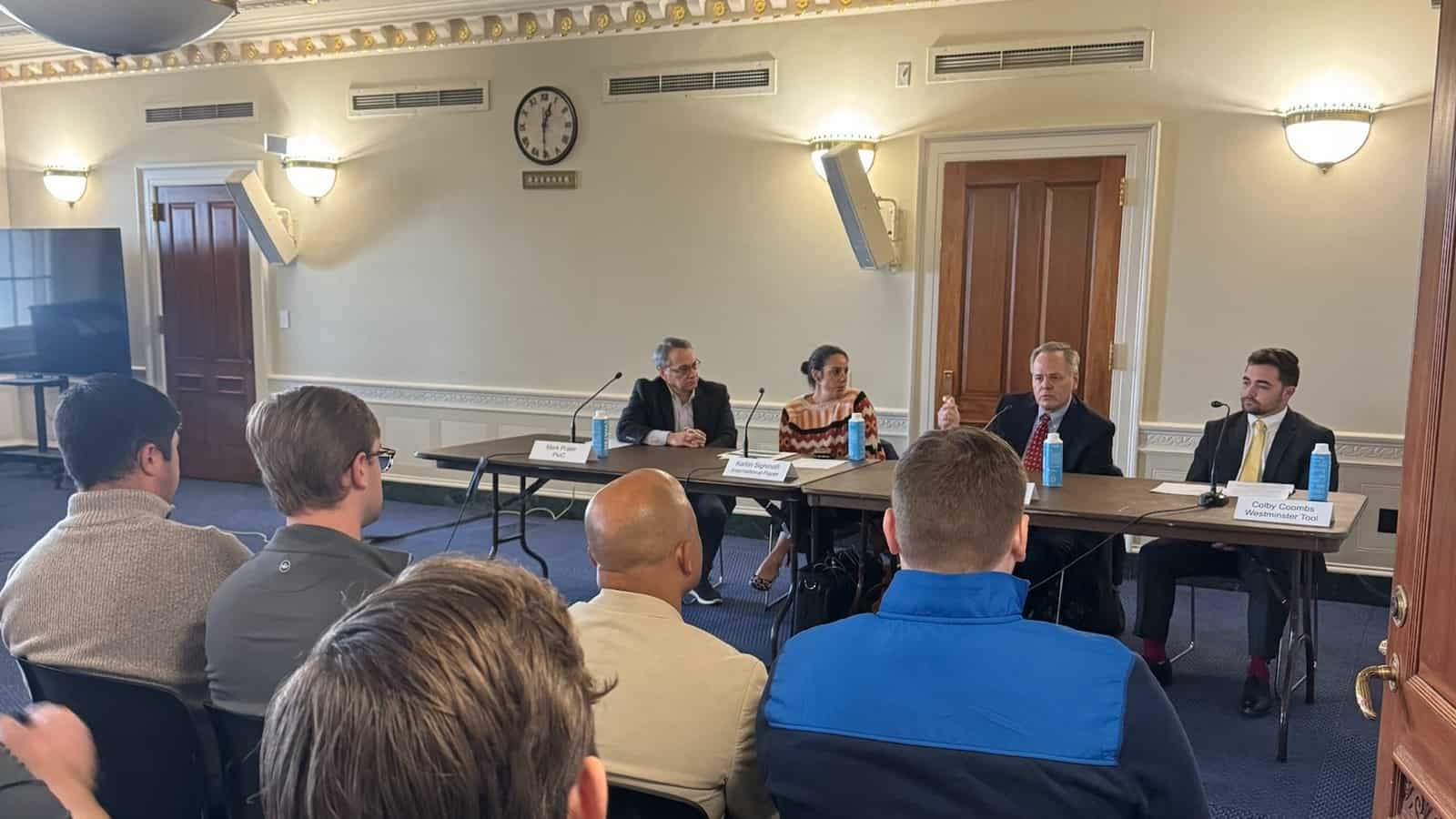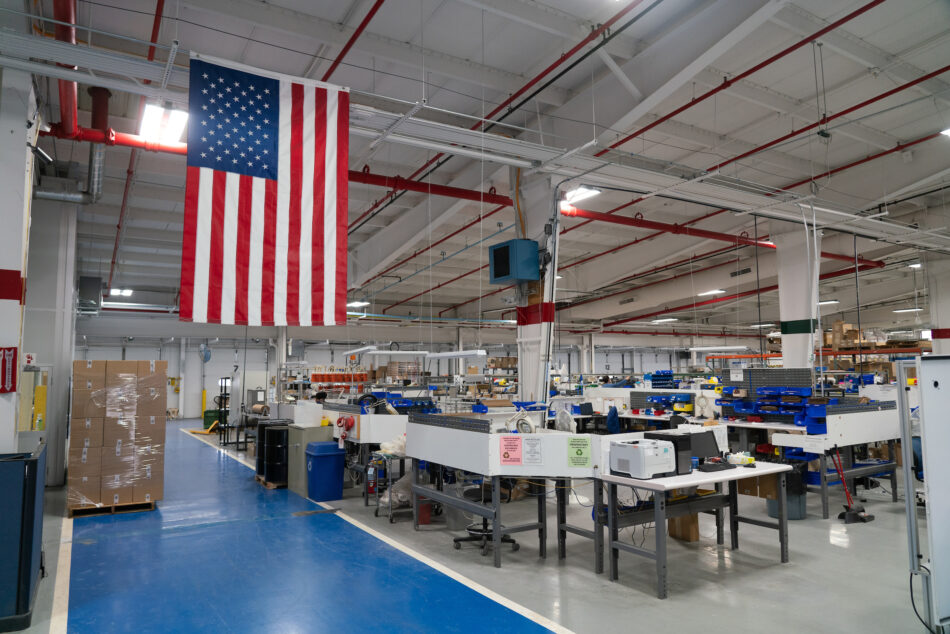NAM Pushes for Sensible Clean Hydrogen Regulations

Manufacturers are working constantly to develop energy approaches that reduce emissions and promote sustainability—and hydrogen energy is an important part of that mix. But upcoming decisions from the U.S. Treasury Department may make it more difficult for manufacturers to achieve their goals.
That’s why the NAM has been advocating for guidance that implements a hydrogen tax credit in a manner that supports manufacturers’ investments in this technology.
The background: Through the Inflation Reduction Act, Congress established this tax credit, called 45V, to incentivize companies to develop, produce and use clean hydrogen.
- “Hydrogen is the Swiss army knife of decarbonization—you can use it for nearly everything you can use natural gas for,” said NAM Vice President of Domestic Policy Brandon Farris. “And this credit can be the most significant tool across the globe to bring down the cost of clean hydrogen.”
The problem: As the U.S. Treasury Department finalizes rules around the use of the tax credit, their decisions may undercut manufacturers’ ability to take full advantage of it. Three provisions in particular are at the center of the NAM’s advocacy.
Additionality: The Treasury Department is considering a policy called “additionality,” which would mean that only hydrogen power created through the use of new renewable energy would be eligible for the credit.
- Meanwhile, clean hydrogen energy created with renewable energy that is already on the grid would not qualify—a real problem as our permitting system can often take half a decade or more to add additional clean power to the grid.
- “We have a lot of renewables on the grid already to spur the hydrogen industry. Using existing clean generation should qualify for the credit,” said Farris.
Time matching: Treasury may also impose a provision called “time matching,” which would mean companies would only receive the tax credit if they produce hydrogen energy at the exact same time that they are producing renewable energy.
- According to Farris, this rule misunderstands the energy production process. A company might only produce solar power for a few hours during the day when the sun is shining, for example, but it could still continue to produce clean hydrogen energy overnight using the grid. Yet under the time matching rule, they would be unable to claim a tax credit for the full amount.
- “This provision would create such tight restrictions that it would chill investment and innovation,” said Farris.
Carbon capture: According to the IRA, clean hydrogen created using natural gas with carbon capture also qualifies for the credit.
- However, the IRA also says taxpayers applying for the credits should have a mechanism to demonstrate that their feedstocks are lower in carbon intensity—yet has not specified what that mechanism will be.
- “Taxpayers applying for the credits should be able to prove that their feedstocks have less carbon,” said Farris. “The law says the less carbon they produce, the higher the credit they should receive. We’re just asking for a mechanism that allows taxpayers to prove it.”
The bottom line: Investments in clean hydrogen energy could be a game-changer for America’s energy future, but only if manufacturers have the opportunity to make them. That’s why the NAM has been urging the Treasury Department to create a flexible credit that rejects the additionality and time matching provisions and provides a mechanism that supports carbon capture.
- “Hydrogen is one of the most promising decarbonization technologies available,” said Farris. “If we can make these changes, we can achieve greater hydrogen production and more significant infrastructure investments and expedite decarbonization efforts across hard-to-abate sectors.”
New Study: “Right-to-Repair” Stifles Innovation, Threatens Consumer Safety
Washington, D.C. – The National Association of Manufacturers released a new study, “The Economic Downsides of Right-to-Repair,” which highlights the cost to the environment, consumer safety and manufacturing innovation of providing unfettered access to complex software and components in manufactured goods. The study analyzes the wide range of unintended and potentially harmful consequences of “right-to-repair” legislation.
The study finds that instituting “right-to-repair” polices directly counteracts many federal laws put in place to protect both manufactures and consumers. The study states that, “bypassing the proper channels for repair will come at a steep cost to quality, performance, consumer safety, the environment and the broader U.S. economy.”
Notably, “right-to-repair” policies could seriously disrupt original equipment manufacturers’ supply chains, which would leave many consumers—especially in rural communities—without a reliable and efficient place to get a repair. “This could increase costs for customers significantly, as delays in placing equipment back in service directly affect a business’s bottom line,” the study warns. The study further highlights an Environmental Protection Agency estimate that more than 500,000 tons of excess emissions have entered the atmosphere since 2009 due to operators disabling or modifying emission controls in vehicles across multiple industries.
“For decades, manufacturing innovation has created new products and technologies that improve modern life,” said NAM Managing Vice President of Policy Chris Netram. “Unfortunately, so called ‘right-to-repair’ policies would threaten these programs, resulting in harm to the environment and putting American’s data and safety at risk.”
Background: In 2021, President Joe Biden signed an executive order encouraging the Federal Trade Commission to enact policies limiting OEMs’ ability to prevent nonauthorized entities from performing certain repairs. The NAM submitted comments to the FTC, calling “right-to-repair” legislation a, “solution in search of a problem.” As of 2023, New York, Minnesota and Colorado have enacted “right-to-repair” legislation, and 23 other states have also considered legislation that would force manufacturers to provide direct access to replacement parts, grant unfettered access to the central processor and further limit their ability to constrain what consumers can do with their product.
-NAM-
The National Association of Manufacturers is the largest manufacturing association in the United States, representing small and large manufacturers in every industrial sector and in all 50 states. Manufacturing employs nearly 13 million men and women, contributes $2.91 trillion to the U.S. economy annually and accounts for 53% of private-sector research and development. The NAM is the powerful voice of the manufacturing community and the leading advocate for a policy agenda that helps manufacturers compete in the global economy and create jobs across the United States. For more information about the NAM or to follow us on Twitter and Facebook, please visit www.nam.org.
Right-to-Repair Laws Harm Manufacturers and Consumers

So-called “right-to-repair” policies undo many of the federal and state laws designed to protect consumers and manufacturers—and they could result in “steep cost[s] to quality, performance, consumer safety, the environment and the broader U.S. economy,” according to a new NAM-commissioned study.
What’s going on: “The Economic Downsides of ‘Right-to-Repair,’” by Capital Policy Analytics’ Ike Brannon and Kerri Seyfert, finds that enacting right-to-repair laws could disrupt supply chains, leave manufacturers open to intellectual property theft, drive up costs for consumers and manufacturers and increase greenhouse emissions in the atmosphere.
- Right-to-repair policies, currently in place in more than 30 states, generally require manufacturers to make all tools, guides and parts required to repair their devices available to everyone, including independent repair outfits.
- A federal right-to-repair law “would ultimately alter how manufacturers operate their businesses, and there is no guarantee that consumers would benefit, as manufacturers would be forced to change the way their products perform,” according to the study.
Why it’s important: “There is a wide range of unintended and potentially harmful consequences that would arise if the most commonly introduced versions of ‘right-to-repair’ go into effect,” Brannon and Seyfert write.
- In addition to making product repair more difficult, such policies could drastically increase compliance costs for manufacturers and drive up prices for consumers.
Reform PBMs, NAM Tells Congress

Pharmacy benefit managers—companies that were first established to manage the cost of prescription drugs—are now driving up pharmaceutical prices for employers and patients, the NAM told the House Committee on Energy and Commerce this week.
What’s going on: While manufacturers remain committed to providing health benefits to their workers, PBMs are “[c]ontributing to the increasing costs of health care,” said NAM Vice President of Policy Chris Netram on Monday, ahead of the committee’s markup of 44 pieces of legislation.
- These measures included the Protecting Patients Against PBM Abuses Act and the Medicare PBM Accountability Act.
Why it’s important: PBMs operate with a virtual monopoly, as just a few of them now control up to 89% of the prescription drug market, Netram continued.
- PBMs operate with limited federal oversight and frequently steer business toward pharmacy networks owned by their parent firms.
What should be done: Congress should pass legislation aimed at changing the PBM model.
- “The complex formulas and opaque business practices of PBMs must come to an end,” the NAM wrote in a social post Tuesday. “Congress must address PBM reform to increase transparency, ensure pharmaceutical savings are passed to the plan sponsor and patients and delink PBM compensation from the list price of drugs.”
In related news: CVS Health “will move away from the complex formulas used to set the prices of the prescription drugs it sells, shifting to a simpler model that could upend how American pharmacies are paid,” The Wall Street Journal (subscription) reports.
Manufacturers to Congress: Restore Pro-Growth Tax Policies Now

In the third quarter of 2023, private-sector R&D spending fell by 1.2%, according to the Bureau of Economic Analysis. Since a harmful R&D amortization requirement took effect in 2022, R&D spending’s rate of growth has slowed dramatically, from 6.6% on average over the previous five years to less than 1% over the past 12 months.
- To protect well-paying R&D jobs and America’s competitiveness, Congress must restore immediate R&D expensing, manufacturers told Congress this week.
What’s going on: At a Monday briefing for staffers of the Main Street Caucus—a group of more than 70 Republican House members that advocates for small businesses—Westminster Tool Chief Financial Officer Colby Coombs talked about the harmful impact the R&D tax change has had on his injection-mold-making business.
- “We’re paying more than double what we made in cash profit last year to the IRS for federal income tax,” he said.
- “To put it differently, we paid just under an additional $27,000 per full-time employee in [our] tax bill this year. It is impossible to continue running your organization paying this amount in taxes [and] not being able to expense our research and development expenditures immediately.”
The background: For close to seven decades, the U.S. tax code allowed businesses to immediately deduct R&D expenses. But starting in 2022, it began requiring companies to amortize, or deduct, these costs over a period of years.
- Also in 2022, a stricter interest limitation—essentially a tax on investment—went into effect. According to a new analysis recently released by the NAM, the stricter limitation could cost nearly 900,000 jobs.
- Earlier this year, full expensing, which allows businesses to deduct the full cost of capital equipment purchases, began to phase down. It is set to fully phase out by 2027.
The effects: According to the Q2 2023 NAM Manufacturers’ Outlook Survey, 78% of manufacturers say the higher tax burden has decreased the funds available to expand core manufacturing activities in the U.S.
- The tax changes “forced us to cancel a major aviation contract this year that would’ve added five new jobs in our community,” Coombs continued. “Five jobs might not seem a lot, but that’s almost 17% of our workforce growth.”
- “We do what we love, which is make good products and make improvements for our country, [but] this is greatly handicapping our ability to continue to grow.”
NAM in action: The NAM has mounted an all-out campaign calling on lawmakers to reinstate immediate R&D expensing, pro-growth interest deductibility and full expensing (or 100% accelerated depreciation).
- Earlier this month, the NAM led more than 1,300 businesses and associations in calling for the measures’ reinstatement.
- It also launched the Restoring Pro-Growth Tax Policies Action Center, which provides background information on these priorities, as well as a digital engagement tool that helps manufacturers and industry advocates contact their senators and representatives.
The last word: Manufacturers are “absolutely vital … to continu[ing] to create good products that are safe and environmentally innovative to help our country,” Coombs said.
- “We need to be able to fully expense immediately, and we need to retroactively fix this [situation] so we can put our money into growing our workforce, purchasing new machines and improving our capabilities so we can compete at a global level.”
NAM Fights Restrictive Power Plant Rule

The Environmental Protection Agency is considering a rule that would change the way power plants operate in America—but without significant adjustments, it could have devastating consequences.
The background: Right now, about 60% of America’s power generation comes from a combination of coal and natural gas.
- The EPA’s proposed rule would require coal and natural gas–fired power plants to deploy either carbon capture technology or hydrogen power within 10 years to lower emissions.
- If unable to deploy these technologies at the scale required in that timeframe, these power plants would be forced to shut down.
The problem: While carbon capture and hydrogen power technologies are vital to decarbonization, the required scale and timeline make implementing this rule difficult.
- “Carbon capture and hydrogen are tremendously promising—and manufacturers are leading the way in developing these technologies. But neither have been deployed at the scale needed to support 60% of our entire power generation within a short timeframe,” said NAM Vice President of Domestic Policy Brandon Farris.
The timeline: The EPA’s proposed 10-year timeline leaves little room for flexibility when it comes to implementing the order. According to Farris, environmental impact studies alone could take more than four years.
- “We’re talking about 10 years to essentially retrofit more than half of our power generation,” said Farris. “You would need this permitted, installed and operational within those 10 years, which would be difficult even if the technology was available today at scale.”
The impact: The rule would require plants that do not meet the new standard in 10 years to shut down entirely. As a result, many plants would have to shift resources immediately to plan for a likely shutdown.
- “The big hammer is these plants having to shut down in 10 years if these technologies are not installed,” said Farris.
- “So you’ll see a lot of money spent and not a lot of progress made because this technology isn’t ready at scale, and we have only a few years to permit, install and operate.”
The next steps: The NAM has submitted comments on the rule, and the EPA is working on a final version now.
- “We’ve emphasized that the timeline is not workable,” said Farris. “You would need to have a longer off-ramp and a way to ensure that the technologies required are proven at scale.”
NAM, Partners: Pass MTB Now

For nearly three years, many manufacturers in the U.S. have been operating at a disadvantage to their foreign competitors due to the lack of a Miscellaneous Tariff Bill. And that needs to change, the NAM told Congress yesterday.
What’s going on: The NAM, along with more than 200 manufacturers and industry partners, urged key members of the House and Senate to pass the MTB as soon as possible this year.
- The measure—which expired at the end of 2020—temporarily eliminates or reduces tariffs on products not readily available in the U.S. and is typically renewed by Congress every few years on a bipartisan basis.
- The previous MTB was passed unanimously in 2018, and in June 2021, the Senate approved an amendment including it and other trade provisions by a strong bipartisan vote of 91–4.
Why it’s important: Since the last MTB’s expiration, manufacturers and other businesses have paid more than $1.4 billion in anticompetitive tariffs to get items they are unable to source in the U.S., according to an NAM analysis.
- In addition to incentivizing overseas manufacturing and costing jobs, the additional expenses are harming local economies and American taxpayers by increasing the prices on manufactured goods.
What should be done: “Congress can reverse course by passing the MTB through 2026 with meaningful retroactivity and reauthorizing future MTB cycles without broad and arbitrary restrictions that would be difficult to implement,” the NAM and partner groups said.
- “Congressional passage of the MTB will spur growth: according to the U.S. International Trade Commission, tariff relief under the previous MTB boosted U.S. GDP annually by as much as $3.3 billion and output annually by as much as $6.3 billion.”
The last word: “If Congress is serious about supporting manufacturers and workers in the United States, they must prioritize the passage of the MTB by the end of this year,” said NAM Director of Trade Facilitation Policy Ali Aafedt.
NAM Hosts 2023 Manufacturing Legal Summit

Every day, manufacturers face complex legal and regulatory challenges that can harm their companies’ bottom lines. Too often, in-house legal staff are forced to navigate this difficult and unpredictable climate alone.
That’s where the NAM’s Manufacturing Legal Summit comes in to provide support. Held on Nov. 6–7 in Washington, D.C., the second-annual Legal Summit brought together in-house counsel from manufacturing companies across the nation to share vital information and practical tools to address the ever-changing legal and regulatory landscape.
“From changes in the law to an increase in enforcement actions to an onslaught of new regulations, manufacturers are facing a more complicated legal environment than ever before,” said NAM Deputy General Counsel for Litigation Erica Klenicki. “Our summit offers the kind of practical legal tools manufacturers need to succeed—and a national network of manufacturing peers that doesn’t exist anywhere else.”
Exploring issues: The Legal Summit covered a range of topics, including the following:
- Supply chain integrity: A team of experts from the law firm Foley & Lardner (partners Greg Husisian, Elizabeth Haas and Marcos Carrasco Menchaca) and Aurorium General Counsel Fernanda Beraldi discussed new supply chain integrity requirements, helping participants understand shifting rules and providing practical solutions to identify and manage risks.
- The NLRB: The priorities and actions of the current National Labor Relations Board present a significant pro-labor shift. Fisher Phillips Managing Partners Steve Mitchell and Steve Bernstein offered context and a critical look ahead.
- Data privacy: Husch Blackwell Partner David Stauss laid out the trends and implications of privacy law at the state and federal level.
- Cyber risk: In a presentation from Baldwin Risk Partners National Director of Cyber Product Emily Perry Short, attendees learned about the impact of cyberattacks and regulations—and what manufacturers need to know to keep their businesses safe.
- SCOTUS: A conversation between former Acting Solicitor General of the United States Neal Katyal and NAM Chief Legal Officer Linda Kelly offered a behind-the-scenes look at oral advocacy before the U.S. Supreme Court and laid out the stakes for manufacturers in the Court’s upcoming term.
- Product liability: Participants learned about best practices for navigating adverse events in regulated industries from a panel comprised of former Commissioner of the Consumer Product Safety Commission Joseph Mohorovic, two seasoned products liability attorneys, Steve Karg and Carol Welborn Reisman, and an in-house counsel at GE Appliances, Jeff Sefton.
- Ethics: Tom Spahn, counsel for McGuireWoods, led an interactive program addressing ethical issues for in-house counsel.
Creating a network: In addition to providing practical knowledge and real-world strategies, the Legal Summit offered manufacturing counsel the opportunity to meet one another, exchange ideas and develop a strong network.
- “General counsels offices for manufacturers are spread out across the country, and so rarely have a chance to convene as a group,” said Michael Tilghman, litigation counsel at the NAM. “That’s something that’s very unique to this summit, which is a great opportunity to build supportive networks.”
Making waves: Participants shared positive reactions to the program.
- “The feedback shared by my team was overwhelmingly positive and complimentary of the job your (small, but mighty) team did in putting together the agenda and speakers,” said Jason Brown, vice president, general counsel and secretary of GE Appliances. “Kudos to [the NAM Legal Center] and those behind the scenes that supported you in this effort. It is already on our calendar for next year.”
The last word: “The NAM Legal Center is an incredible resource and an important part of navigating the current climate,” said Klenicki. “I hope that participants come away from this summit not only with new tools and understanding, but with the knowledge and appreciation that the NAM Legal Center has their back.”
NAM Pushes Back on Restrictive Chemical Rule

The Environmental Protection Agency is considering an effective ban of a chemical compound called ethylene oxide. However, abruptly eliminating the chemical from use could have profound negative consequences for manufacturers and make modern life much more difficult.
The background: Ethylene oxide is a chemical used in a wide range of products, from textiles to plastics to antifreeze. It’s also used to sterilize certain medical devices—and in some cases, it’s the only chemical effective for that purpose.
The problem: The EPA is considering a new regulation that would set the acceptable levels of the chemical in the atmosphere so low that it amounts to a ban on the compound.
- “If you took a monitor outside in any U.S. city center, where no manufacturing production occurs, the level of ethylene oxide would be higher than the level the EPA is proposing,” said NAM Vice President of Domestic Policy Brandon Farris.
- “So anywhere that manufactures or uses ethylene oxide would be above the level they’re suggesting. The EPA is effectively banning it by creating a level that’s so low it can’t possibly be met.”
The impact: Because there are no current substitutes for some uses of ethylene oxide, a de facto ban would have immediate and serious impacts.
- “If this rule is finalized, a large number of medical devices could no longer be sterilized, and a lot of items that are relied on for modern life, such as textiles, plastics, household cleaners and adhesives, could not be produced in their current form,” said Farris. “If the EPA moves forward with this proposal, there will be no alternatives for the critical uses of this compound.”
The timeline: The final rule is expected to be released in the next few months. If the EPA chooses to finalize the rule in its current form—which would create a de facto ban on production and usage—manufacturers would be required to find a replacement for the chemical immediately. Developing a replacement in such a short amount of time will be difficult if not impossible.
- “One of the problems with creating a regulatory timeline for replacement is that science doesn’t work on an agency’s timeframe,” said Farris. “With no off-the-shelf substitute, it could take years to replace essential products, if we’re able to replace them at all.”
Our actions: The NAM is pushing back aggressively on this rule and raising manufacturers’ concerns with the White House, Congress and the EPA.
The bottom line: “This as proposed is a bad regulation,” said Farris. “Policymakers need to go back to the drawing board, recognize the critical applications of ethylene oxide and develop a proposal that is grounded in reality.”
Learn more about the NAM’s efforts to fight regulatory overreach here.
NAM Pushes Back on Restrictive Chemical Rule

The Environmental Protection Agency is considering an effective ban of a chemical compound called ethylene oxide. However, abruptly eliminating the chemical from use could have profound negative consequences for manufacturers and make modern life much more difficult.
The background: Ethylene oxide is a chemical used in a wide range of products, from textiles to plastics to antifreeze. It’s also used to sterilize certain medical devices—and in some cases, it’s the only chemical effective for that purpose.
The problem: The EPA is considering a new regulation that would set the acceptable levels of the chemical in the atmosphere so low that it amounts to a ban on the compound.
- “If you took a monitor outside in any U.S. city center, where no manufacturing production occurs, the level of ethylene oxide would be higher than the level the EPA is proposing,” said NAM Vice President of Domestic Policy Brandon Farris.
- “So anywhere that manufactures or uses ethylene oxide would be above the level they’re suggesting. The EPA is effectively banning it by creating a level that’s so low it can’t possibly be met.”
The impact: Because there are no current substitutes for some uses of ethylene oxide, a de facto ban would have immediate and serious impacts.
- “If this rule is finalized, a large number of medical devices could no longer be sterilized, and a lot of items that are relied on for modern life, such as textiles, plastics, household cleaners and adhesives, could not be produced in their current form,” said Farris. “If the EPA moves forward with this proposal, there will be no alternatives for the critical uses of this compound.”
The timeline: The final rule is expected to be released in the next few months. If the EPA chooses to finalize the rule in its current form—which would create a de facto ban on production and usage—manufacturers would be required to find a replacement for the chemical immediately. Developing a replacement in such a short amount of time will be difficult if not impossible.
Read the full story here.
